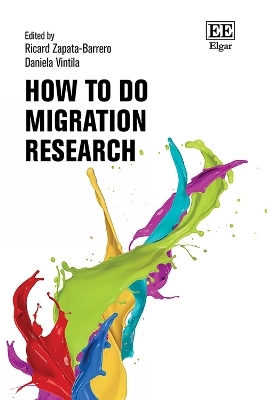
How to Do Migration Research
Edward Elgar Publishing Ltd (Verlag)
978-1-0353-0684-8 (ISBN)
Analyzing diverse disciplinary perspectives from across the field of migration studies, this book identifies valuable practical approaches to studying human mobility. Chapters cover key features of migration research including contested concepts, mixed-methods approaches, archival data collection and intersectional, ethical research design. Contributing authors show that migration issues are intertwined with complex power dynamics and increasing inequalities that define contemporary societies. They critically examine cutting-edge issues in the field, from the use of social media and public opinion data to the design of indices and indicators.
How to Do Migration Research is a vital resource for human mobility researchers seeking to refine their analytical skills and learn impactful publishing strategies. Highlighting the multidisciplinary nature of the field, it is also an excellent guide for students and scholars of sociology, anthropology, geography and political science seeking a gateway into migration research.
Edited by Ricard Zapata-Barrero, Interdisciplinary Research Group on Immigration (GRITIM-UPF), Department of Political and Social Sciences, Universitat Pompeu Fabra, Spain and Daniela Vintila, Centre for Ethnic and Migration Studies (CEDEM), Faculty of Social Sciences, University of Liège, Belgium
Contents
Introduction: doing migration research today as an engaged and
conscientious scholar 1
Ricard Zapata-Barrero and Daniela Vintila
PART I DISTINCTIVE FEATURES IN MIGRATION RESEARCH
1 Working with contested concepts in migration research 9
Ricard Zapata-Barrero
2 Interdisciplinarity in migration research 17
Jan Rath
3 Intersectional research for migration studies 24
Parvati Raghuram and Gunjan Sondhi
4 Mixed methods: bridging the qualitative–quantitative
divide in migration research 33
Jørgen Carling
5 Migration research beyond the nation state 41
Verena Wisthaler and Mireille Paquet
PART II DOING QUALITATIVE MIGRATION RESEARCH
6 The pros and cons of qualitative research in the field of
migration: some practical tips 49
Justyna Salamońska
7 Multi-sited comparative research designs in migration studies 57
Valentina Mazzucato
8 Ethnographic approaches in migration research 65
Franck Düvell
9 Subjectivity and rigour in the use of qualitative analysis software 73
Guy Drudi and Bob W. White
10 Archival data and migration research 81
Monica Varsanyi
PART III DOING QUANTITATIVE MIGRATION RESEARCH
11 Strengths and challenges of quantitative migration
research: some practical aspects 89
Daniela Vintila
12 Surveys in migration research 98
Steffen Pötzschke
13 Experimental migration research 107
Daniel Auer
14 Social media data and migration research 115
Jasper Tjaden
15 Public opinion on international migration in cross-national
surveys 124
Abdeslam Marfouk
16 The design and use of migration indices and indicators 133
Luicy Pedroza and Pau Palop-García
PART IV COMMUNICATING AND SHARING
MIGRATION RESEARCH FINDINGS
17 Reflexivity in migration research 143
Leila Hadj Abdou
18 Ethical issues in communicating and sharing migration
research findings 151
Christina Clark-Kazak
19 A literature review of migration studies 158
Nathan Levy, Asya Pisarevskaya and Peter Scholten
20 Disseminating migration research findings to the public 172
Ernesto Castañeda
21 Publishing migration research: epistemological challenges
of journal articles 180
Irina Isaakyan
22 Policy-relevant migration research: how to create impact 188
Albert Kraler
| Erscheinungsdatum | 21.08.2024 |
|---|---|
| Reihe/Serie | How to Research Guides |
| Verlagsort | Cheltenham |
| Sprache | englisch |
| Maße | 156 x 234 mm |
| Themenwelt | Sozialwissenschaften ► Soziologie ► Empirische Sozialforschung |
| ISBN-10 | 1-0353-0684-0 / 1035306840 |
| ISBN-13 | 978-1-0353-0684-8 / 9781035306848 |
| Zustand | Neuware |
| Haben Sie eine Frage zum Produkt? |
aus dem Bereich


